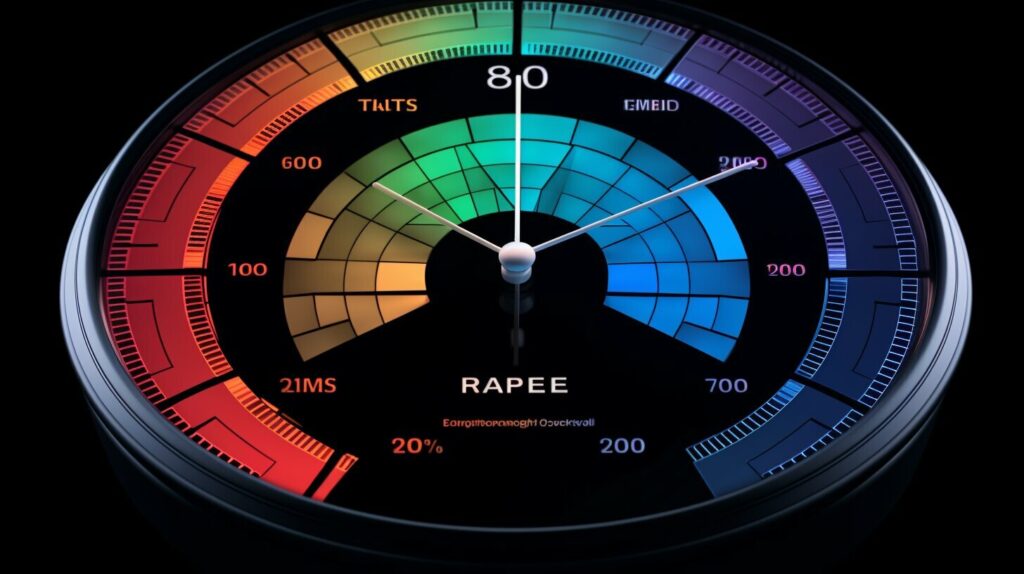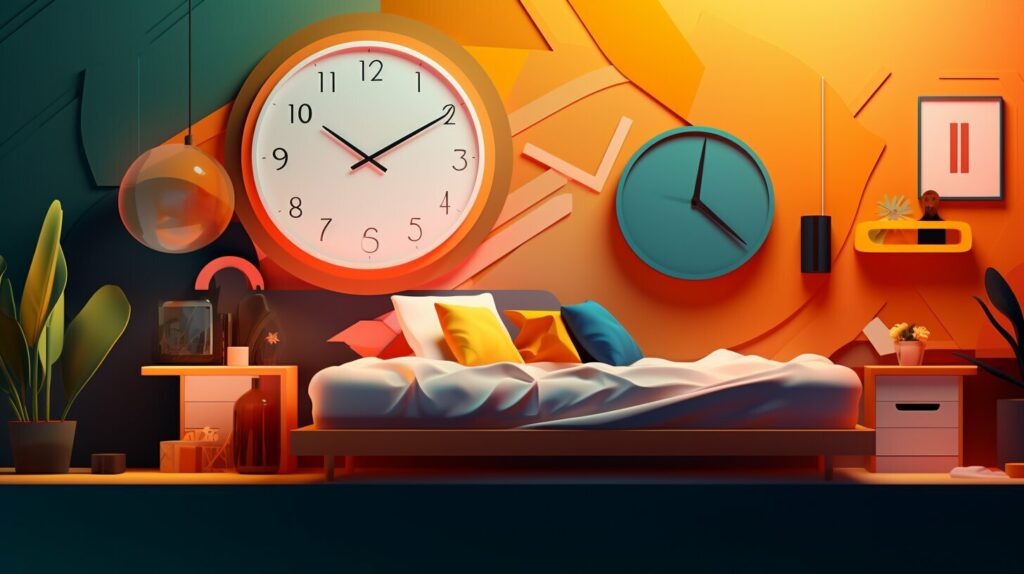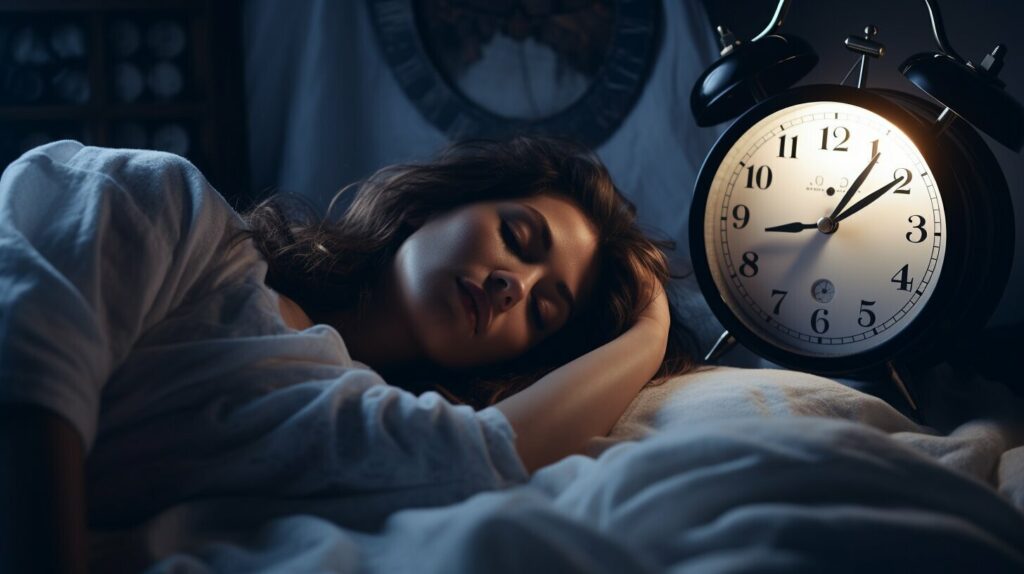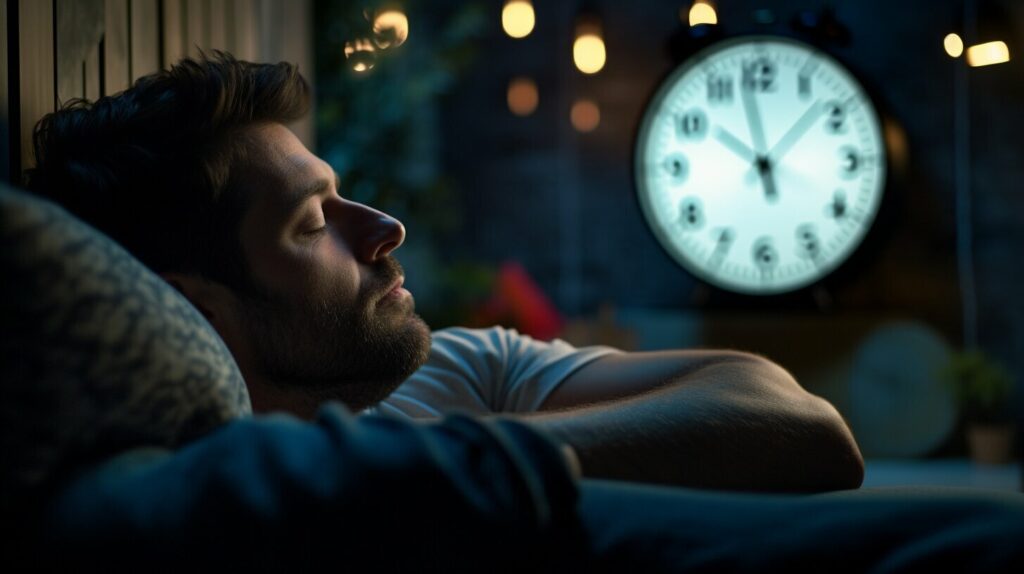*This post may contain affiliate links for which I earn commissions.*
Have you ever taken a short nap and wondered, can you dream in a 15 minute nap? It’s a common question, especially if you want to boost your creativity or solve a problem during your nap.
The answer is yes, you can dream during a 15-minute nap. However, the likelihood of dreaming during such a short nap depends on several factors, including the sleep stage and length of your nap. Let’s take a closer look at the science behind dreaming during naps.
Key Takeaways:
- It is possible to dream during a 15-minute nap.
- The likelihood of dreaming depends on various factors.
- The stages of sleep play a significant role in dreaming.
Understanding Sleep Cycles and Dreams
When it comes to understanding dreaming during short naps, it’s essential to know about the different stages of sleep. There are two main stages: REM (Rapid Eye Movement) sleep and non-REM sleep. Rapid eye movements, increased brain activity, and vivid dreams characterize REM sleep. On the other hand, non-REM sleep is characterized by slower brain waves and less dreaming.
During a full sleep cycle, which typically lasts around 90 minutes, you will go through several stages of non-REM sleep before entering REM sleep. It’s during the REM stage that most dreaming occurs. However, you may still enter REM sleep and experience vivid dreams even during a short nap.
It’s worth noting that the timing of your nap can also play a role in whether you dream or not. If you nap during the day, your body is more likely to be in a REM state, which means you are more likely to experience dreams. Meanwhile, napping during the evening or at night may result in less dreaming, as your body may have a deeper non-REM sleep state.

Rapid eye movements, increased brain activity, and vivid dreams characterize REM sleep.
The Science Behind Napping
Napping has been shown to have numerous benefits for cognitive function and memory processing. During a nap, your brain processes information and consolidates memories, allowing for better retention and recall. This is especially true during sleep’s cognitive memory processing stage, which occurs during naps and complete sleep cycles.
Microsleep, a phenomenon characterized by brief periods of sleep, is also a crucial aspect of napping. Microsleep helps to combat sleep deprivation and increase alertness, allowing you to perform better on cognitive tasks and make fewer errors.
In fact, a power nap of just 20 minutes can significantly improve cognitive functioning, while a longer 60-minute nap can enhance creativity and problem-solving abilities. However, the optimal nap length varies depending on the individual, their sleep needs, and the time of day.
Creating a sleep-friendly environment can also enhance the benefits of napping. Ensure that your nap environment is quiet, dark, and calm, and avoid consuming caffeine or engaging in stimulating activities before napping.

Napping can be a powerful tool for boosting cognitive function and memory processing. Still, it’s essential to understand the science behind it and tailor your nap routine to your individual needs.
The Importance of Nap Length
When it comes to napping, the length of your nap can significantly impact the quality of sleep you get and whether or not you are likely to dream.
Short naps, such as 20-minute power naps, are less likely to involve deep sleep or REM sleep, which are the stages of sleep where dreaming is most common. However, even during a short nap, it is still possible to enter these stages of sleep and, therefore, to dream.
If you want to increase your chances of dreaming during a nap, a longer nap of around 60 minutes may be more effective. This nap length allows your body to enter deeper stages of sleep, including REM sleep, which is associated with vivid dreaming.
| Nap Length | Stages of Sleep | Potential for Dreaming |
|---|---|---|
| 20 minutes | Light sleep | Low |
| 60 minutes | Deeper sleep, including REM sleep | High |
Ultimately, the length of your nap should be chosen based on your goals and schedule. A shorter nap may be more effective if you’re looking for a quick burst of energy. However, a longer nap may be more beneficial if you’re looking to boost creativity and memory consolidation.

Factors Affecting Dreaming in Short Naps
While it is possible to dream during a 15-minute nap, several factors can affect the likelihood and intensity of dreaming. One factor is sleep deprivation, as the body may require more time in deep sleep to fully rest and engage in dreaming. Additionally, the time of day can play a role, as the body’s natural circadian rhythm may make it more challenging to enter specific sleep stages during certain times of the day.
Another factor to consider is sleep inertia, which refers to the groggy or disoriented feeling that can occur upon waking from a nap. This can be particularly problematic for those needing to maintain alertness and focus after a nap. To minimize the potential for sleep inertia and maximize the potential for dreaming, it is vital to create a sleep-friendly environment, including ensuring that the nap location is quiet and dark and using relaxation techniques such as deep breathing and meditation to prepare the mind and body for sleep.
It is important to note that not everyone will experience dreaming during a 15-minute nap, and some individuals may experience dreamless naps altogether. However, by creating an optimal nap routine and understanding the factors that can impact dreaming during short naps, you can increase your chances of experiencing rejuvenation and improved cognitive function following a quick nap.

Tips for Enhancing Dreaming in Short Naps
If you want to make the most of your 15-minute nap and boost your creativity and memory processing, there are several tips that you can follow:
- Relax: Before you take your nap, take some time to relax. Find a quiet space where you won’t be interrupted, and try relaxation techniques like deep breathing or meditation. This will help you fall asleep more quickly and improve the quality of your nap.
- Create a sleep-friendly environment: Make sure your nap environment is comfortable and conducive to sleep. Dim the lights, wear an eye mask, and use earplugs or noise-canceling headphones if necessary. You can also try using aromatherapy with essential oils like lavender to help you relax.
- Visualize: Before you nap, visualize something you want to dream about. This can help you enter your dreams more quickly and have more vivid dreams.
- Avoid caffeine and sugar: Consuming caffeine or sugar before your nap can interfere with the quality of your sleep and make it harder to dream.
Remember, prioritizing relaxation and creating a sleep-friendly environment is the key to enhancing your dreaming during a short nap. Following these tips can maximize your 15-minute nap and boost your creativity and memory processing.

The Benefits of Dreaming
Dreaming during short naps isn’t just a possibility – it can also offer a range of benefits for your cognitive and emotional well-being. When you dream, you enter into the rapid eye movement (REM) stage of sleep, during which your brain is highly active, processing and consolidating memories from the day before.
Beyond memory consolidation, dreaming can foster creative problem-solving and offer emotional release and psychological insight. Research shows that dream therapists can use clients’ dreams to help them work through personal issues and that people who dream regularly tend to have better problem-solving skills and more creativity.
Dreaming can also help with the processing of emotions. In one study, participants who were shown emotionally charged images before a nap later reported feeling less distressed about the images after having dreamt about them.
Importantly, dreaming also plays a role in overall sleep quality. Dreaming during a nap can help you feel more rested and alert upon waking up, leading to better overall sleep health.

In fact, the benefits of dreaming extend beyond just the nap – research suggests that even a few minutes of daytime dreaming can help improve cognitive processing throughout the rest of the day.
To maximize the benefits of dreaming, allowing yourself enough time for a good nap is crucial and creating a comfortable and relaxing environment that promotes restful sleep is crucial. Whether you’re feeling sleepy mid-afternoon or need a quick boost of creativity, dreaming during a short nap can offer a range of benefits for your cognitive and emotional well-being.
The Importance of Nap Length
It’s essential to consider the length of your nap if you hope to experience dreaming during your rest. While dreaming can occur during any stage of the sleep cycle, it’s more likely to happen during REM sleep, which typically occurs about 90 minutes after falling asleep. Therefore, if you’re aiming for a shorter nap, such as a 15 or 20-minute “power nap,” you may not have enough time to enter REM sleep and experience dreaming. On the other hand, if you opt for a longer nap of around 60 minutes, you’ll have a greater chance of entering REM sleep and potentially experiencing vivid dreams.
It’s also worth noting that the length of your nap can impact how you feel when you wake up. Shorter naps are less likely to cause feelings of grogginess or “sleep inertia,” which can occur after longer naps when you wake up in the middle of a sleep cycle. However, longer naps can provide more restorative benefits, such as improved cognitive function and memory processing.

Ultimately, the optimal length of your nap will depend on your individual sleep needs and schedule. If you only have a short nap time, focus on creating a relaxing environment and allowing yourself to drift into a light sleep. If you have more time available, aim for a longer nap and be prepared for the possibility of vivid dreaming.
Creating an Optimal Nap Routine
Creating a nap routine that works for you is key to ensuring you get the most out of your short nap. When planning your nap routine, remember that the length of time you nap can significantly impact your cognitive function and memory consolidation.
First, find a quiet and dark location to take your nap. This minimizes distractions and creates a sleep-friendly environment that can enhance the quality of your nap.
Second, determine the optimal length of time for your nap. While a 20-30 minute nap can improve alertness and productivity, a 60-minute nap can increase creativity and memory processing.
Next, consider the time of day you are taking your nap. Napping too close to bedtime can interfere with your ability to fall asleep at night while napping during the mid-afternoon can be the most optimal time for a nap.
It’s also important to note that sleep inertia, or grogginess upon waking, can be a potential downside of napping. To combat this, try to time your nap so that you wake up during a lighter stage of sleep, such as stage 1 or 2.
Finally, if you struggle with falling asleep quickly, consider implementing relaxation techniques such as deep breathing or meditation into your nap routine. This can help you fall asleep faster and enhance the quality of your nap.

Remember, the key to creating an optimal nap routine is finding and sticking to what works best for you. By implementing these tips and techniques, you can ensure that your short nap is restful, rejuvenating, and enhances cognitive function.
Napping Frequency and Sleep Health
While short naps can provide a helpful boost to your energy levels and cognitive function, it’s essential to be mindful of how often you nap. Excessive napping can actually lead to sleep deprivation and severe sleep disorders.
According to sleep experts, napping too often can disrupt your natural sleep schedule and lead to difficulty falling asleep at night. For adults, it’s generally recommended to limit naps to no more than 20-30 minutes a day and to avoid napping later in the day as it may interfere with your ability to fall asleep at night.
While napping can be a helpful way to recharge, it’s important to prioritize getting enough sleep at night, as this is crucial for overall health and well-being. Rather than relying on frequent naps, focus on creating a consistent sleep schedule and practicing good sleep hygiene habits to ensure restful and rejuvenating sleep.
Key Points:
- Excessive napping can lead to sleep deprivation and severe sleep disorders
- Limit naps to no more than 20-30 minutes a day
- Avoid napping later in the day to prevent difficulty falling asleep at night
- Focus on creating a consistent sleep schedule and practicing good sleep hygiene habits

Making the Most of Short Naps
Sometimes you need to take a quick nap but don’t have enough time to dream. Fortunately, there are strategies you can use to maximize the benefits of a short nap and increase alertness.
One effective technique is to focus on relaxation. You can try deep breathing exercises, or progressive muscle relaxation, where you tense and then release different muscle groups throughout your body. This can help reduce stress and promote calmness, even if you don’t fall asleep.
If you have time to sleep, try to create a quiet, dark environment conducive to rest. You can use an eye mask or earplugs to block out light and noise and ensure you’re comfortable with a pillow or blanket.
Another technique is to try a caffeine nap, where you consume a small amount of caffeine before taking a 15-20 minute nap. The caffeine will start to take effect after you wake up, helping to increase alertness and reduce feelings of grogginess.
If you feel dreamless after a short nap, try getting up and moving around. Doing light stretching or taking a quick walk can help energize your body and mind, improving alertness and reducing fatigue.
Remember that a short nap aims not necessarily to dream but to improve alertness and rejuvenate your body. By incorporating relaxation techniques and creating a sleep-friendly environment, you can make the most of even the shortest nap and feel more alert and refreshed throughout the day.

The Conclusion: Can You Dream In A 15 Minute Nap?
After exploring the science and benefits of napping and the factors that can impact dreaming during short naps, it is clear that it is possible to dream during a 15-minute nap. While longer naps may increase the likelihood of dreaming, short naps can benefit cognitive function and memory processing.
Remember, creating an optimal nap routine that considers factors such as nap length and sleep environment can help maximize the potential for dreaming and rejuvenation. However, it’s essential to be mindful of excessive napping, which can disrupt your sleep schedule and lead to sleep deprivation.
Incorporating short naps into your daily routine can help boost creativity, improve memory consolidation, and enhance overall well-being. So go ahead and take that 15-minute nap, and dream away!
FAQ
Q: Can You Dream In A 15 Minute Nap?
A: Yes, it is possible to dream in a 15-minute nap. While shorter naps may not include as much dream time as longer sleep periods, dreaming can still occur during these brief rest periods.
Q: Understanding Sleep Cycles and Dreams
A: Sleep cycles consist of different stages, including REM sleep and deep sleep. Dreaming often occurs during REM sleep, which is the stage associated with vivid dreams and rapid eye movement.
Q: The Science Behind Napping
A: Napping, such as power naps or microsleeps, can enhance cognitive function and improve memory processing. It provides a chance for the brain to rest and recover, leading to better mental performance.
Q: The Importance of Nap Length
A: The nap length can impact sleep quality and whether dreaming is likely to occur. Shorter naps, around 20 minutes, are less likely to include dreaming than longer naps, around 60 minutes.
Q: Factors Affecting Dreaming in Short Naps
A: Dreaming during short naps can be affected by factors such as sleep deprivation, time of day, and sleep inertia. These factors can influence the brain’s ability to enter REM sleep and experience dreams.
Q: Tips for Enhancing Dreaming in Short Naps
A: To enhance dreaming during a 15-minute nap, try relaxation techniques such as deep breathing or imagining a peaceful scene. Creating a sleep-friendly environment, such as using a comfortable pillow or eye mask, can also help.
Q: The Benefits of Dreaming
A: Dreaming has several benefits, including aiding in cognitive memory processing and problem-solving abilities. Dreaming during REM sleep can also contribute to emotional well-being and creativity.
Q: Addressing Concerns and Downsides
A: While dreaming during short naps can be beneficial, individuals with sleep disorders may experience disruptions. Grogginess upon waking is another potential downside, which can be mitigated by giving yourself enough time to transition out of sleep.
Q: Creating an Optimal Nap Routine
A: To create an optimal nap routine, find the right time to suit your needs. Understanding brain activity during naps can also help determine the ideal duration and ensure restful sleep.
Q: Napping Frequency and Sleep Health
A: While napping can be beneficial, excessive napping can disrupt overall sleep health, especially if it leads to sleep deprivation at night. Finding the right balance between napping and nighttime sleep is key.
Q: Making the Most of Short Naps
A: If you only have a short amount of time for a nap and dreaming may not be possible, focus on increasing alertness and rejuvenation. Stay hydrated, stretch, or take a brisk walk after the nap to boost energy levels.
Conclusion
In a 15-minute nap, it is possible to dream, although the amount of dream time may be limited. Napping can still provide numerous benefits, such as cognitive restoration and improved mental performance, even without extensive dreaming.







